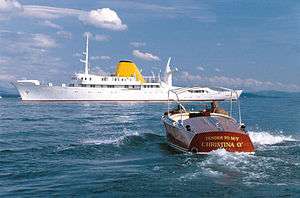Luxury yacht

A Luxury yacht (also super-yacht, large yacht and mega-yacht) is a very expensive, privately owned, professionally crewed sailing or motor yacht.
There is no industry-wide standard for the difference between super-yacht and mega-yacht. The only legal distinction is between yachts above 24 metres (79 ft) and below, as in some countries those above 24 meters must have a permanent crew onboard.[1]
This term began to appear at the beginning of the 20th century, when wealthy individuals constructed large private yachts for personal pleasure, such as Charles Henry Fletcher's Jemima F. III, at 111 feet, the largest motor-powered yacht in the world in 1908.[2] More examples of early luxury motor yachts include the Cox & King yachts, Charles L. Seabury and Company's yachts, M/Y (motor yacht) Christina O, and M/Y Savarona.
Today

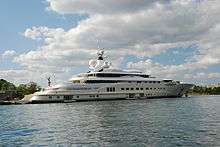
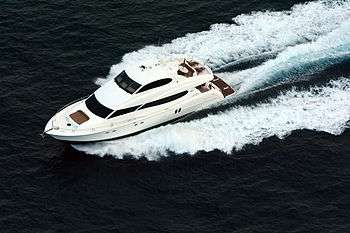
Between 1997 and 2008, there was a massive growth in the number, size, and popularity of large private or super-sized luxury yachts in the 24-to-70-metre (79 to 230 ft) size range. Luxury yachts, mega-yachts, or super-yachts typically have no real home port as such, although a yacht must be registered in a port of the country where its flag state is registered. Popular flag state registrars for large yachts are Cayman Islands, Marshall Islands, Isle of Man, and the British Virgin Islands, among others. (Many times the yacht will have never been to these ports.) They are particularly bountiful in the Mediterranean Sea in summer and the Caribbean Sea in winter. Some can be chartered (rented) for sums of up to 1 million Euro per week. Yachts will dock in a port of choosing while the crew does maintenance work and waits for owners or guests to arrive. The vessels then will do short cruises with the owners and/or guests aboard. Typical destinations in Spain and the French and Italian Rivieras include Cannes, Antibes, St. Tropez, Monte Carlo, Portofino, Porto Cervo, Puerto Banús, Puerto Portals, and Palma, Majorca, although increasingly luxury yachts are cruising in more remote areas of the world. Antigua is one of the main ports in the Windward Islands of the Caribbean and hosts a Charter Show at the beginning of the winter season.
While the demand for new luxury yachts has slowed somewhat since 2009, 2011 has seen a small rebound with launches from many of the top yards. The 163.5 metres (536 ft) M/Y Eclipse, was built by Blohm + Voss for Russian businessman Roman Abramovich[3] and the 180 metres (590 ft) Azzam launched in 2013 are the largest private yachts in the world. Luxury boatbuilding and yacht charter companies are predominantly based in Western Europe and the United States but are also increasingly found in Australia, New Zealand, Asia, and Eastern Europe.
As of 2016 there were about 10,000 luxury yachts, worldwide, over 24 metres in length. The annual production rate was reported to be around 150.[4]
Charter
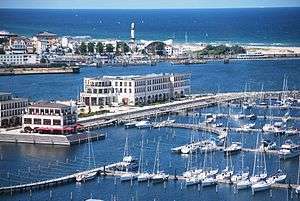
Some yachts are used exclusively by their private owners, others are operated all year round as charter businesses, and a large number are privately owned but available for charter part-time. The weekly charter rate of luxury yachts around the world ranges from tens of thousands to over a million dollars/euros. Expenses of approximately 20–30%, such as food, fuel, and berthing are charged as an extra, called the advance provisioning allowance. The luxury yacht charter industry functions effectively because private yacht owners mitigate their running costs with charter income as well as keeping their yachts and crew in top running order. Conversely, private charterers charter yachts (rather than owning them) because it is generally considered to be less expensive, and less hassle, than owning a yacht and it also provides them with extra choice related to yacht type, location and crew.[5]
Design and layout
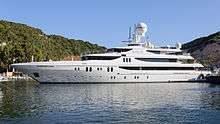
Yachts from 24 metres (79 ft) and up qualify for design awards, but given the number of yachts exceeding 100 feet, many set the minimum length for a super-yacht higher. A 45-to-50-metre (148 to 164 ft) yacht, the smallest with a generally accepted claim to super-yacht status, will usually be a three-decker with cabins for 10–12 guests and for a crew of a similar size. The accommodation on this type of yacht is typically as follows:
- Lower deck: exterior swimming platform at the stern; four (sometimes five) guest cabins with en-suite bath aft; engine room amidships; crew quarters forward.
- Main deck: sheltered exterior deck aft leading into the saloon; dining room and galley; entrance amidships; owner's suite forward, usually includes a study, and sometimes a second stateroom for a personal assistant/bodyguard.
- Upper deck: exterior deck aft, often used for outdoor dining; second saloon (often called the sky lounge); sixth stateroom will be amidships if it is not on the lower deck or part of the owner's suite; captain's cabin; bridge.
- Sun deck: the uppermost deck, often features a jacuzzi and sometimes a glass-enclosed gym (which can also be below decks or even part of the owner's suite).
A 50-metre yacht will have one or more luxury yacht tenders for reaching shore and other "toys" which may include a speed boat or sailing boat, personal water craft, windsurfing and diving equipment and a banana boat. Up-to-date yachts have multiple televisions and satellite communications.
The number of very large yachts has increased rapidly since the 1990s, and increasingly only yachts above around 65 metres (213 ft) stand out among other luxury yachts. Yachts of this size are almost always built to individual commissions and cost tens of millions of dollars (most super-yachts cost far more than their owners' homes on land, even though those homes are likely to be among the largest and most opulent). A yacht of this size usually has four decks above the waterline and one or two below. It is likely to have a helicopter landing platform. Apart from additional guest cabins, which are likely to include one or more "VIP suites" besides the owner's suite, extra facilities compared to a 50-metre (160 ft) yacht will include some or all of the following: indoor jacuzzis, sauna and steam rooms, a beauty salon, massage and other treatment rooms, a medical centre, a disco (usually the same space as the sky lounge or saloon, transformed into a dance area when furnishings are moved aside and special lighting activated), a cinema, plunge pool (possibly with a wave-maker), a playroom, and additional living areas such as a separate bar, secondary dining room, private sitting rooms or a library. There will be more boats and "toys" than there are on a 50-metre (160 ft).
Giga-yacht

Giga yachts is a hyperbolic term that first emerged in reference to megayachts, a.k.a. superyachts, in the mid-2000s. Power & Motoryacht magazine's popular Megayachts forum, which was online from the early 1990s to 2012 (now offline), had an ongoing discussion about the term, since luxury yachts at that time were getting larger and larger, exceeding 300 feet in length (about 91 meters). The words megayacht and super-yacht basically mean the same thing, despite the term super-yacht being more prevalent outside of U.S. these days. The word megayacht was coined by yacht broker George Nicholson of Camper & Nicholsons, quoted in one of the first issues of Power & Motoryacht magazine in 1985 as well as subsequent media reports elsewhere.[6] As of 2012, yachts above 100 metres (330 ft) are still rare but increasingly more common, with an estimated 32 on the water.[3] They typically have five decks above the water line and one below. They incorporate many of the same features that smaller mega-yachts do, such as helicopter landing areas and swimming pools, though given their extra length, they also feature helicopter hangars and miniature submarines.
Crew
The crew required to operate a large or super-sized luxury yacht can number from 8 members for a 120 ft yacht, to a complement of 70 for a yacht the size of Eclipse. The crew is made up of a captain, first mate or officer, chief engineer, engineers, bosun, personal chef, crew chef, deckhands, purser, and stewards. Luxury yachts are maintained by crew all year round but will often scale down to a skeleton crew during the seasons that the owners are not on board and no charters are booked. Most crew members live on board and are paid a monthly salary, with most living expenses covered by the owner. Live-on-board crews do not pay rent, food, electricity or water bills. All luxury yachts have crew areas below deck, which consist of a crew mess, crew cabins and laundry. While most crew cabins contain bunk beds, there are captains and chief engineers who, on the larger yachts, have their own cabins. There are no set hours that crew members work each week. The hours depend greatly on how often the owners are on board, how often it is chartered and on what hours the captain sets when there are no guests on board. The crew can be hired through crew agencies or various websites.
See also
References
- ↑ "RYA regulations".
- ↑ "Queen of Motor Yachts, The Jemima F. III., Largest in the World, Launched in the Harlem" (PDF), The New York Times, New York, p. 1, 17 July 1908
- 1 2 Top 100 Largest Super-yachts, Boat International, 2012, retrieved 1 February 2012
- ↑ Nineham, Laura (August 22, 2016). "Megayachts explained". Boat International. Retrieved 2018-06-28.
- ↑ Bestic, Ralph (May 22, 2017). "5 superyachts to charter". Australian Financial Review. Melbourne: Fairfax Media. (Subscription required (help)).
- ↑ Goodstein, Laurie (October 7, 1990). "Traveling Yacht Owners Giving Pricey Harbor Basins the Slip : Real estate: None have sold at glamourous North Cove port. 'Dockominium' values range up to $2.5 million". Washington Post. Washington.
